Learning Curve — South Florida Plants
Jeff Wasielewski, Former Assistant Curator of Tropical Fruit
I have twenty-nine years of experience. I have been learning from day one: language, motor-skills, reading, writing and arithmetic. Everyone has been. We all learn every day. When Hurricane Andrew blew me outdoors, my new interest in horticulture led me to learn all I could on the subject, studying books from the library, volunteering and working at the Garden, attending lectures given by various plant societies, taking classes and eventually earning a horticultural degree from Miami-Dade Community College.
All of these things taught me about horticulture, but nothing taught me as much as simply taking a few minutes a day to look at my garden. There I learned things that were hidden between the lines of my books or lost in a professor's lecture notes. My garden has taught me what works. Healthy plants don't lie. I encourage you to try the same approach. Walk in your garden when you come home from work. See what the lady bugs are doing to the aphids. Ask yourself why a particular plant isn't doing well. Does it get too much water or sunlight, or is it just not adapted to our soils? Your garden holds the answers. Mine has taught me well.
Growing plants in South Florida can be difficult. Poor soils, dry winters and a host of insect pests can cause your plants to sicken or die. If you ask me how I beat the problems posed by the South Florida landscape, I will repeat the answers my garden has given me.
One answer is to grow what is suited to our conditions. Following are my top South Florida plants, all adapted to our poor soils and brutal summers. Each one is tried and true, resistant to drought, pests and fungus. They are bullet proof.
Large Trees
Live Oak, Quercus virginiana
This splendid, massive, beautiful native tree can reach heights of 60 feet with a spread almost as wide. Its rough textured bark is the perfect host for epiphytes such as orchids and bromeliads. It needs a large space and should not be planted under power lines. It is a slow grower resulting in strong, dense wood that can be used for woodworking and firewood. Plant young trees to ensure a healthy root system.
Gumbo Limbo, Bursera simaruba
The Gumbo Limbo may be my all time favorite tree. Glossy leaves perched above a glowing red bark make this tree the beauty pageant winner of the native plant world. One of the fastest growing trees I know, it quickly provides shade in newly planted gardens. The fast growth rate also produces brittle wood, so don't plant it too close to the house. The gumbo limbo can be easily grown from cuttings, but I recommend trees grown from seed, which have better developed root systems and will stand up better in a storm.
Native Tamarind Lysiloma latisiliquum
The native tamarind is another fast growing large native tree that can be used to provide shade. The small leaflets give the tree a feathered, graceful look. The bark is smooth and attractive, the fruit, inedible. The tree is host to harmless tree snails and numerous small insects which attract many species of birds making it a good tree to watch from afar.
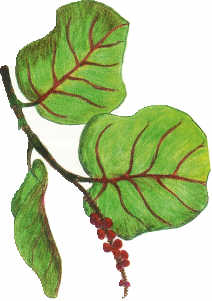 |
| Sea grape (Coccoloba uvifera) based on a drawing by Elizabeth Smith |
Sea Grape, Coccoloba uvifera
The Sea Grape is a fast growing tree that can be heavily pruned to produce a medium sized tree or a hedge, although I recommend using it as a specimn planting. The large leaves are red and glossy when young and quite attractive. The tree can either be male or female. If you have a female tree, you can look forward to wine colored bunches of grape sized berries which are are edible. Make sure you are really, really hungry before you try one of these fruit otherwise you may prefer to leave them to the birds. The varying shades of tan and brown of its bark are its best feature, giving it a painted quality.
Mango, Mangifera indica
The mango is the king of tropical fruit. The delicious fruit can be used in a variety of ways from mango salsa to being eaten out of hand. The handsome shade tree can reach heights of 45 feet or more; however, through cultivar selection and light pruning, trees can be kept to a manageable eight to ten feet. It is also a good epiphyte tree; its coarse bark provides housing for several different species of orchids and bromeliads.
Avocado, Persea americana
The avocado is another tropical fruit that can produce luscious fruit with minimal input from the homeowner. The tree doesn't like having its roots wet, so plant it in a dry location. The tree can reach heights of 45 feet or more, but may be pruned to maintain a convenient height. Don't let fruit trees get too tall because the taller the tree, the harder it is to pick the fruit. Don't plant the avocado where falling fruits will be a hazard, as the heavy, solid fruit may hurt pedestrians or damage automobiles.
Small Trees, Large Shrubs
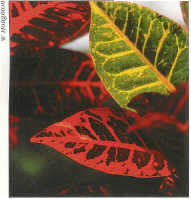 |
| Croton, Codiaeum variegatum |
Croton, Codiaeum variegatum
The croton is an old time South Florida favorite. Its colorful appearance doesn't come from showy flowers, but from its leaves. They can be pink, yellow, green or shades thereof, and come in a variety of shapes and sizes. Plant it in full sun or partial shade; leaf color is related to the amount of sun it receives. Although it can reach heights of ten feet, it is very manageable, and can be pruned and maintained at three to seven feet if desired.
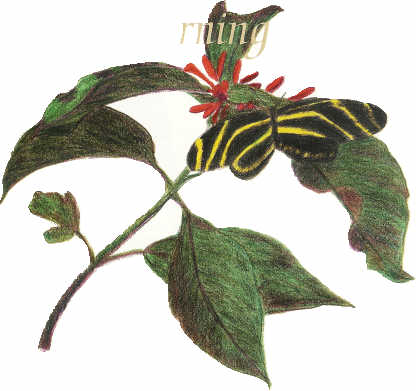 |
| Firebush (Ramella patens) witb zebra longwing butterfly Based on a drawing by Elizabeth Smith |
Firebush, Hamelia patens
The fire bush is a Florida native. Its small, red, tubular flowers and red-tinged leaves give the plant its name. The flowers attract butterflies and hummingbirds and the fruit attracts a variety of other birds. The ten-foot tree can be maintained as a small tree or pruned back to a three-foot shrub. It blooms throughout the year. If the fire bush is planted near the native passionflower, Passiflora suberosa, you will have a complete habitat for zebra longwing butterflies.
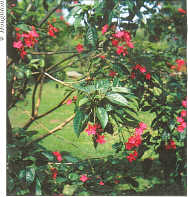 |
| Jatropha integerrima |
Jatropha, Jatropha integerrima
The attractive jatropha can be used as a small tree reaching heights of 12 feet or pruned to a three to four foot shrub. The plant's dark green leaves are accented by dark red blooms which last throughout the year. The flowers attract butterflies.
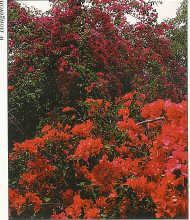 |
| Bougainvillea sp. |
Bougainvillea, Bougainvillea sp.
The bougainvillea is a vigorous vine that produces incredible shows of color. The red, pink, orange or white color explosions come from bracts which surround the small, inconspicuous flowers. Bougainvillea can stand on its own, but does best when grown on a trellis or tree. Its small thorns make it a good barrier to ani mals or people. The vine responds well to heavy pruning and will flower best when given a minimal amount of fertilizer and little to no irrigation.
Small Shrubs
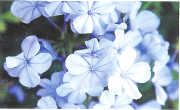 |
| Plumbago, Plumbago auriculata |
Plumbago, Plumbago auriculata
The plumbago comes in white or light blue and produces a heavy bloom throughout the year. If cut back hard, it will come back nicely. It can reach heights of six feet, but I like to maintain it at two. It will bloom in dappled shade as well as full sun and is extremely drought tolerant.
Thryallis, Gaiphimia gracilis
The thryallis combines dark green foliage with numerous year-round bright yellow flowers that seem to glow. The plant does best in full sun. It may reach heights of five feet, but can be maintained at two. It responds well to occasional heavy pruning.
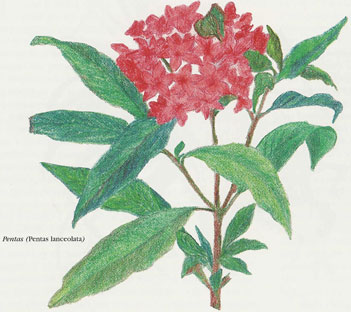
Pentas, Pentas lanceolata
Pentas attract butterflies and hummingbirds with flowers of white, red, pink and purple. This plant blooms year-round and can be grown as a perennial if heavily pruned each spring. I have had better luck treating it like an annual and replanting when it becomes leggy.
Palms & Cycads
Dioon edule
This attractive cycad is best used in full sun. It spreads three to four feet and can reach heights of four to five feet. While new, the pinnate leaves are soft and delicate, but once mature, they are stiff.
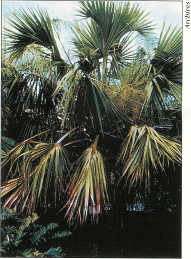 |
| Sabal Palm, Sabal palmetto |
Sabal Palm, Sabal palmetto
The sabal palm is the state tree of Florida. The old leaf bases can be left on the trunk, creating a nice habitat for ferns and epiphytes, or removed if you prefer a clear trunk. The leaves are palmate. Young trees spend many years developing a canopy and an underground trunk before producing a visible trunk. Birds enjoy its fruit.
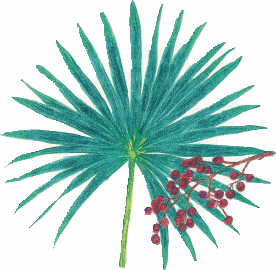 |
| Silver palm (Coccothrinax argentata) based on a drawing by Elizabeth Smith |
Silver Palm, Coccothrinax argentata
The silver palm gets its name from the light-catching, silver sheen of the undersides of its thin, graceful palmate leaves. It seems to glow when the wind catches it. Perrine and North Homestead were once covered by this beautiful native palm. The thin trunk is only four to six inches in diameter. Slow growing, it may be planted within two to three feet of the house. It attracts birds.
Thatch Palm, Thrinax radiata
The dark green, palmate leaves of the thatch palm have a yellow eye in the center of the frond. It produces white fruit which attracts birds. The fast growing tree looks best when planted in groups. This Florida native is a perfect palm to build a landscape around. Its trunk reaches six to eight inches.
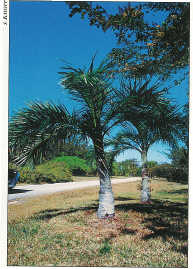 |
| Sargent's Palm, Pseudophoenix sargentii |
Sargent's Palm, Pseudo phoenix sargentii
The incredibly beautiful Sargent's palm (buccaneer palm) is listed as an endangered species in its native Florida. Its dark-green, pinnate leaves lay in a single plane when young. As they fall, they leave a silver-gray leaf scar on the glowing gray trunk. Its dark-red berries attract birds.
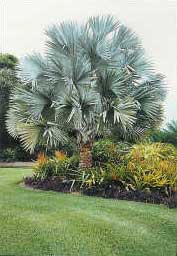 |
| Bismarckia, Bismarckia nobilis |
Bismarckia, Bismarckia nobilis
The large bismarckia has a trunk of two to three feet. It comes in two forms - silver and green. The massive, palmate leaves of the silver form are a silver-gray from tip to leaf base. Specimens can be seen on the Garden's main lawn, surrounded by purple queen. Although expensive, it makes an impressive statement in any landscape.
Veitchia arecina
This veitchia (Syn. Veitchia montgomeryana, Veitchia macdanielsii) is fast growing and can be used in a variety of situations from full sun to medium shade. It is susceptible to frost damage when young, but when mature, can make it through some very cold nights. The dark green, pinnate leaves make this an outstanding landscape palm. It looks best in groups, but can also be used as an accent.
Pygmy Date Palm Phoenix roebelenii
The pygmy date palm can be found in many yards and countless gas stations. Its beauty comes from its graceful, dark-green pinnate leaves. Although not usually a clumping palm, it is often planted in groups of two to four. The palm can reach heights of ten feet with a trunk of four to eight inches. The leaf bases harbor long spines, so be careful when pruning old fronds.
All of these plants are beautifully adapted to South Florida, thriving in our poor soils and strong sun with no irrigation and with little to no fertilizer. There are many other similar plants, and I challenge you to find them. Study the needs of plants you are considering and then try them out. Don't be afraid to try something just to see if it works; some of your best learning experiences will be "mistakes." Your garden will tell you what works and what doesn't. It is only a matter of taking the time to lis ten to what your garden tells you. It's time to see what you can discover in your own backyard.
Garden Views, November 2000